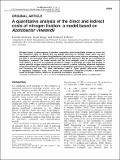A quantitative analysis of the direct and indirect costs of nitrogen fixation: a model based on Azotobacter vinelandii
Author(s)
Bragg, Jason; Follows, Michael J
Downloadismej201697.pdf (700.5Kb)
PUBLISHER_CC
Publisher with Creative Commons License
Creative Commons Attribution
Terms of use
Metadata
Show full item recordAbstract
Nitrogen fixation is advantageous in microbial competition when bioavailable nitrogen is scarce, but has substantial costs for growth rate and growth efficiency. To quantify these costs, we have developed a model of a nitrogen-fixing bacterium that constrains mass, electron and energy flow at the scale of the individual. When tested and calibrated with laboratory data for the soil bacterium Azotobacter vinelandii, the model reveals that the direct energetic cost of nitrogen fixation is small relative to the cost of managing intracellular oxygen. It quantifies the costs and benefits of several potential oxygen protection mechanisms present in nature including enhanced respiration (respiratory protection) as well as the production of extracellular polymers as a barrier to O₂ diffusion, and increasing cell size. The latter mechanisms lead to higher growth efficiencies relative to respiratory protection alone. This simple, yet mechanistic framework provides a quantitative model of nitrogen fixation, which can be applied in ecological simulations.
Date issued
2016-10Department
Massachusetts Institute of Technology. Department of Earth, Atmospheric, and Planetary SciencesJournal
ISME Journal
Publisher
Nature Publishing Group
Citation
Inomura, Keisuke et al. “A Quantitative Analysis of the Direct and Indirect Costs of Nitrogen Fixation: a Model Based on Azotobacter Vinelandii.” The ISME Journal 11, 1 (October 2016): 166–175 © 2017 International Society for Microbial Ecology
Version: Final published version
ISSN
1751-7362
1751-7370